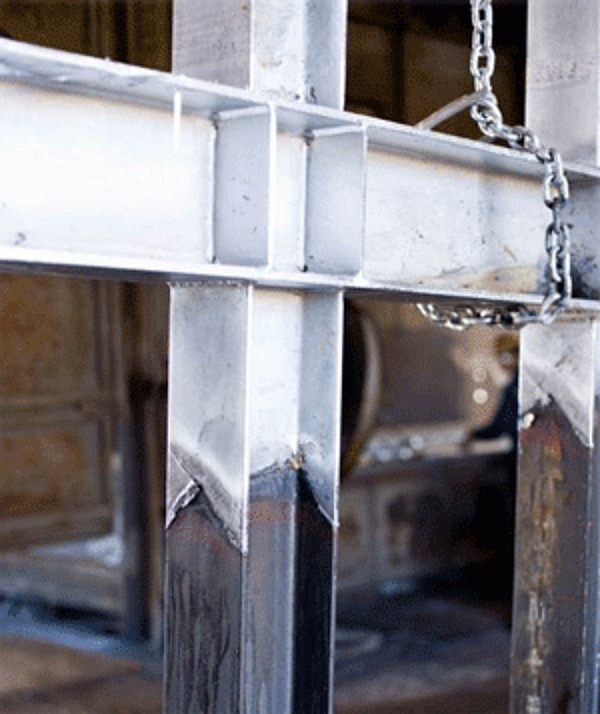Masking Products for Galvanized Steel
*Updated 2025
Can you recommend some products for masking hot-dip galvanized steel?

Masking products are applied to specific areas of steel when the galvanized coating on those areas would interfere with the end use of the product (such as on faying surfaces), or when additional work needs to be done on masked areas and a galvanized coating would make the work more difficult or expensive (such as on areas that will be welded or on fasteners that cannot have any additional width from a zinc coating). Of course, any time steel is masked, there will be no corrosion protection of the steel in those areas. The unmasked areas will not affect the corrosion protection of the galvanized coating in other areas to any large extent.
Many different types of materials have been used to mask steel during hot-dip galvanizing. High temperature paints used for masking are applied to flat surfaces that require the absence of a galvanized coating. The most common application of this is when areas of the steel are to be welded after galvanizing, such as stud welding. The paints can be removed after galvanizing by grinding or brushing, depending on the size of the area that has been masked. Greases and pastes that are resistant to the conditions of the galvanizing process are typically used on internal threads or threaded holes. When pastes are moistened with a little water, they can be pressed into holes and openings; it is essential that care is taken not to trap air in these holes. The paste hardens with the heat of galvanizing and prevents ingress of zinc. It will then be necessary to remove the residue after galvanizing by means of brushing. Adhesive tapes are used on cylindrical components, such as threaded bolts or pins. The tape carburizes in the galvanizing kettle and the residue that remains prevents the galvanizing reaction from occurring. This residue must be removed after galvanizing by using a stiff bristled brush. Another method of masking used to prevent unwanted coating on internal threads or clearance holes is the use of filler bolts or pins. A bolt or pin is greased prior to insertion in the hole and removed after galvanizing. Heat may be required to remove the bolt or pin as the zinc coating may lock the bolt or pin in place.
What Works?
In the years since the AGA’s 2010 study, masking products have left the market, and new products have come to light. Here’s an updated list of masking products tested by the AGA and found to adequately prevent galvanizing.
- GE 100% Silicone Caulk (Home Depot, Lowes)
- Maskote Zinc Stop-Off (Pyrotek)
- Permatex Red RTV (formerly NAPA RTV Red) (Amazon)
- GalvaStop (HUB Industrial, Puma Chemical)
- DAP Household Adhesive Sealant (Home Depot, Lowes)
Here are some products that our galvanizer members have successfully used to mask parts with but have not been tested by the AGA:
- Plasti Dip (Amazon)
- ProCoat Galvbloc Zinc Stopper (TecCoat)
*Products may not be exclusively available from our list’s sources.
Full details of the study can be found in the Galvanizing Note Masking Materials for Preventing Hot-Dip Galvanizing. For more detailed information on how each masking material performed on the various surface types, and application and removal data, please see the charts in Appendix 1.
It is important to remember that no masking material is 100% effective (there will always be some minor areas to clean up afterward), but if applied properly, they are quite effective at minimizing cleanup after HDG. Also, be sure to apply masking materials in accordance with the manufacturer’s instructions regarding cure times, application temp, humidity, surface cleanliness, etc. This will help the material’s adherence and ultimately performance.

Products not designed specifically for hot-dip galvanizing tend to be less expensive than products designed specifically for use during hot-dip galvanizing, but sometimes do not work as effectively; however, each of these products did perform well during testing conducted by the AGA. Regardless if the products used for masking steel were designed specifically for hot-dip galvanizing or not, it is important to always follow the manufacturers recommendations and Material Safety Data Sheets. Speaking of testing, the results of the AGA study on masking materials are now available. The information has been compiled into a white paper that discusses testing on a total of 15 different materials used for masking steel during galvanizing. View the Galvanizing Note, Masking Materials for Preventing Hot-Dip Galvanizing for more information.
© 2025 American Galvanizers Association. The material provided herein has been developed to provide accurate and authoritative information about after-fabrication hot-dip galvanized steel. This material provides general information only and is not intended as a substitute for competent professional examination and verification as to suitability and applicability. The information provided herein is not intended as a representation or warranty on the part of the AGA. Anyone making use of this information assumes all liability arising from such use.


